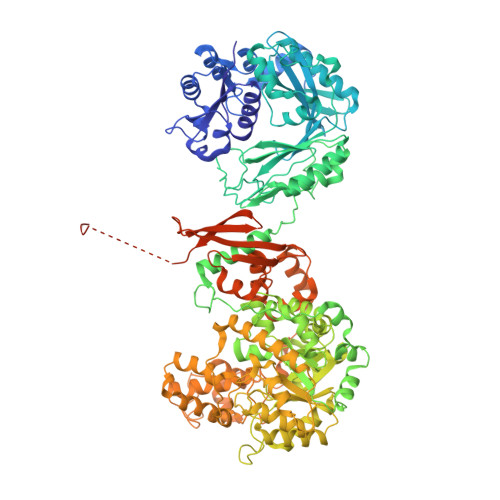Allosteric Site at the Biotin Carboxylase Dimer Interface Mediates Activation and Inhibition in Staphylococcus aureus Pyruvate Carboxylase.
Laseke, A.J., Boram, T.J., Schneider, N.O., Lohman, J.R., St Maurice, M.(2023) Biochemistry 62: 2632-2644
- PubMed: 37603581
- DOI: https://doi.org/10.1021/acs.biochem.3c00280
- Primary Citation of Related Structures:
8GK8 - PubMed Abstract:
Allosteric regulation of the essential anaplerotic enzyme, pyruvate carboxylase (PC), is vital for metabolic homeostasis. PC catalyzes the bicarbonate- and ATP-dependent carboxylation of pyruvate to form oxaloacetate. Dysregulation of PC activity can impact glucose and redox metabolism, which contributes to the pathogenicity of many diseases. To maintain homeostasis, PC is allosterically activated by acetyl-CoA and allosterically inhibited by l-aspartate. In this study, we further characterize the molecular basis of allosteric regulation in Staphylococcus aureus PC ( Sa PC) using slowly/nonhydrolyzable dethia analogues of acetyl-CoA and site-directed mutagenesis of residues at the biotin carboxylase homodimer interface. The dethia analogues fully activate Sa PC but demonstrate significantly reduced binding affinities relative to acetyl-CoA. Residues Arg 21 , Lys 46 , and Glu 418 of Sa PC are located at the biotin carboxylase dimer interface and play a critical role in both allosteric activation and inhibition. A structure of R21A Sa PC in complex with acetyl-CoA reveals an intact molecule of acetyl-CoA bound at the allosteric site, offering new molecular insights into the acetyl-CoA binding site. This study demonstrates that the biotin carboxylase domain dimer interface is a critical allosteric site in PC, serving as a convergence point for allosteric activation by acetyl-CoA and inhibition by l-aspartate.
Organizational Affiliation:
Department of Biological Sciences, Marquette University, Milwaukee, Wisconsin 53201-1881, United States.


















